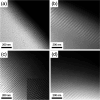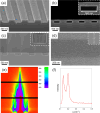Stress-Induced Directed Self-Assembly of Perpendicularly Oriented Block Copolymer Lamellae for Lithographic Density Multiplication
- PMID: 41021907
- PMCID: PMC12516688
- DOI: 10.1021/acsami.5c14351
Stress-Induced Directed Self-Assembly of Perpendicularly Oriented Block Copolymer Lamellae for Lithographic Density Multiplication
Abstract
This work demonstrates a stress-induced directed self-assembly (DSA) approach to produce unidirectionally oriented perpendicular lamellae in block copolymer (BCP) thin films, achieving a smaller line width and a higher aspect-ratio for pattern transfer with lithographic density multiplication. A free-standing polystyrene-block-polydimethylsiloxane (PS-b-PDMS) thin film on a transmission electron microscopy (TEM) grid is thermally annealed under high vacuum inside an in situ, temperature-resolved TEM instrument. The high vacuum reduces the surface tension discrepancy between PS and PDMS at high temperatures, creating neutral surfaces at both top and bottom sides of the thin film and facilitating the formation of film-spanning perpendicular lamellae via self-alignment during thermal annealing. Finite element analysis reveals that the x-directional stress is concentrated at the grid edge, inducing the formation of unidirectionally oriented perpendicular lamellae, as evidenced by an in situ, time-resolved TEM observation. This edge-parallel alignment arises from a tensile stress gradient along the edge-normal direction, which favors lamellae aligned parallel to the edge to minimize elastic mismatch between PS and PDMS during self-assembly. For nanopatterning, the free-standing thin film is transferred onto substrates with e-beam-defined trenches followed by thermal annealing in a homemade vacuum oven. The BCP film gradually flows into the trenches during which the stress guides the formation of unidirectionally oriented perpendicular lamellae. Subsequently, well-defined SiO2 line patterns can be formed within the trenches after O2 reactive ion etching. This facile method enables controlled orientation of a free-standing BCP thin film by integrating vacuum-driven perpendicular orientation and stress-induced DSA, providing appealing potential for fabrication of highly ordered line patterns in advanced lithographic applications.
Keywords: block copolymer; controlled orientation; directed self-assembly; finite element analysis; vacuum.
Figures





References
-
- Bates F. S., Fredrickson G. H.. Block Copolymers Designer Soft Materials. Phys. Today. 1999;52:32–38. doi: 10.1063/1.882522. - DOI
-
- Park C., Yoon J., Thomas E. L.. Enabling Nanotechnology with Self Assembled Block Copolymer Patterns. Polymer. 2003;44:6725–6760. doi: 10.1016/j.polymer.2003.08.011. - DOI
-
- Hawker C. J., Russell T. P.. Block Copolymer Lithography: Merging “Bottom-Up” with “Top-Down” Processes. MRS Bull. 2005;30:952–966. doi: 10.1557/mrs2005.249. - DOI
-
- Segalman R. A.. Patterning with Block Copolymer Thin Films. Mater. Sci. Eng., R. 2005;48:191–226. doi: 10.1016/j.mser.2004.12.003. - DOI
LinkOut - more resources
Full Text Sources

